Remote Sensing Methods for Flood Prediction: A Review
Abstract
:1. Introduction
2. Materials and Methods
- No duplicates;
- Time interval: 2010–2021;
- Document type: research article, abstract, book chapter;
- English language only
3. Results
3.1. Multispectral
3.2. LIDAR
3.3. Radar
4. Discussion
Insights and Future Directions
5. Conclusions
Author Contributions
Funding
Institutional Review Board Statement
Informed Consent Statement
Data Availability Statement
Conflicts of Interest
References
- Alidoost, F.; Arefi, H. Application of Deep Learning for Emergency Response and Disaster Management. In Proceedings of the AGSE Eighth International Summer School and Conference, Tehran, Iran, 29 April–4 May 2017; pp. 11–17. [Google Scholar]
- Tariq, M.A.U.R.; van de Giesen, N. Floods and flood management in Pakistan. Phys. Chem. Earth Parts A/B/C 2012, 47–48, 11–20. [Google Scholar] [CrossRef]
- Du, W.; FitzGerald, G.J.; Clark, M.; Hou, X.Y. Health impacts of floods. Prehospital Disaster Med. 2010, 25, 265–272. [Google Scholar] [CrossRef] [PubMed]
- Kundzewicz, Z.W.; Pińskwar, I.; Brakenridge, G.R. Large floods in Europe, 1985–2009. Hydrol. Sci. J. 2013, 58, 1–7. [Google Scholar] [CrossRef]
- Zhang, Q.; Gu, X.; Singh, V.P.; Xiao, M. Flood frequency analysis with consideration of hydrological alterations: Changing properties, causes and implications. J. Hydrol. 2014, 519, 803–813. [Google Scholar] [CrossRef]
- Grimaldi, S.; Schumann, G.P.; Shokri, A.; Walker, J.P.; Pauwels VR, N. Challenges, opportunities, and pitfalls for global coupled hydrologic-hydraulic modeling of floods. Water Resour. Res. 2019, 55, 5277–5300. [Google Scholar] [CrossRef] [Green Version]
- Ahmad, D.; Afzal, M. Household vulnerability and resilience in flood hazards from disaster-prone areas of Punjab, Pakistan. Nat. Hazards 2019, 99, 337–354. [Google Scholar] [CrossRef]
- RICHARD DAVIES: Asia. 2021. China—Thousands Evacuate Floods in Shanxi. 2021. Available online: https://floodlist.com/asia/china-floods-shanxi-october-2021 (accessed on 17 November 2021).
- Davidson, H. China Floods: Bus Falls into River as Heavy Rains Destroy Homes. 2021. Available online: https://www.theguardian.com/world/2021/oct/11/flooding-in-china-forces-120000-to-flee-homes-amid-record-rainfall (accessed on 12 November 2021).
- Syifa, M.; Park, S.J.; Achmad, A.R.; Lee, C.-W.; Eom, J. Flood Mapping Using Remote Sensing Imagery and Artificial Intelligence Techniques: A Case Study in Brumadinho, Brazil. J. Coast. Res. 2019, 90, 197–204. [Google Scholar] [CrossRef]
- Makker, M.; Ramanathan, R.; Dinesh, S.B. Post Disaster Management Using Satellite Imagery and Social Media Data. In Proceedings of the 2019 4th International Conference on Computational Systems and Information Technology for Sustainable Solution (CSITSS), Bengaluru, India, 20–21 December 2019. [Google Scholar]
- Watik, N.; Jaelani, L. Flood Evacuation Routes Mapping Based on-Flood Impact Analysis from Landsat 8 Imagery Using Network Analyst Method. Int. Arch. Photogramm. Remote Sens. Spat. Inf. Sci. 2019, 4238, 455–460. [Google Scholar] [CrossRef] [Green Version]
- Shah, S.A.; Seker, D.Z.; Hameed, S.; Draheim, D. The Rising Role of Big Data Analytics and IoT in Disaster Management: Recent Advances, Taxonomy and Prospects. IEEE Access 2019, 7, 54595–54614. [Google Scholar] [CrossRef]
- Saravi, S.; Kalawsky, R.; Joannou, D.; Rivas-Casado, M.; Fu, G.; Meng, F. Use of Artificial Intelligence to Improve Resilience and Preparedness Against Adverse Flood Events. Water 2019, 11, 973. [Google Scholar] [CrossRef] [Green Version]
- Widiasari, I.R.; Nugroho, L.E.; Widyawan. Deep learning multilayer perceptron (MLP) for flood prediction model using wireless sensor network based hydrology time series data mining. In Proceedings of the 2017 International Conference on Innovative and Creative Information Technology (ICITech), Salatiga, Indonesia, 2–4 November 2017. [Google Scholar]
- Tehrany, M.S.; Pradhan, B.; Jebur, M.N. Flood susceptibility analysis and its verification using a novel ensemble support vector machine and frequency ratio method. Stoch. Hydrol. Hydraul. 2015, 29, 1149–1165. [Google Scholar] [CrossRef]
- Anusha, N.; Bharathi, B. Flood detection and flood mapping using multi-temporal synthetic aperture radar and optical data. Egypt. J. Remote Sens. Space Sci. 2019, 23, 207–219. [Google Scholar] [CrossRef]
- Joshi, N. How AI Can and Will Predict Disasters. 2019. Available online: https://www.forbes.com/sites/cognitiveworld/2019/03/15/how-ai-can-and-will-predict-disasters/?sh=511c00ac5be2 (accessed on 28 September 2021).
- Riaz, M.; Atif, S. A Geosensor Site Suitability Analysis for Flood Early Warning/Management in the Indus River Basin. In Water Management in South Asia; Springer Nature: Basingstoke, UK, 2020; pp. 103–122. [Google Scholar] [CrossRef]
- Nelson, E.L.; Bustamante, N.D.; Kivlehan, S.M. Chapter 17: Global Public Health Disaster Management and Technology; Springer: Cham, Switzerland, 2020; pp. 275–289. [Google Scholar] [CrossRef]
- Priya, M.G.; Divya, N. Measurement to Management: Study of Remote Sensing Techniques for Flood Disaster Management. J. Remote Sens. GIS 2019, 255, 6–9. [Google Scholar]
- Fan, C.; Zhang, C.; Yahja, A.; Mostafavi, A. Disaster City Digital Twin: A vision for integrating artificial and human intelligence for disaster management. Int. J. Inf. Manag. 2019, 56, 102049. [Google Scholar] [CrossRef]
- Crétaux, J.-F.; Arsen, A.; Calmant, S.; Kouraev, A.; Vuglinski, V.; Bergé-Nguyen, M.; Gennero, M.-C.; Nino, F.; Del Rio, R.A.; Cazenave, A.; et al. SOLS: A lake database to monitor in the Near Real Time water level and storage variations from remote sensing data. Adv. Space Res. 2011, 47, 1497–1507. [Google Scholar] [CrossRef]
- Hall, A.C.; Schumann, G.J.-P.; Bamber, J.L.; Bates, P.D.; Trigg, M.A. Geodetic corrections to Amazon River water level gauges using ICESat altimetry. Water Resour. Res. 2012, 48, 6. [Google Scholar] [CrossRef] [Green Version]
- Webster, T.L. Flood Risk Mapping Using LiDAR for Annapolis Royal, Nova Scotia, Canada. Remote Sens. 2010, 2, 2060–2082. [Google Scholar] [CrossRef] [Green Version]
- Sharma, T.P.P.; Zhang, J.; Koju, U.A.; Zhang, S.; Bai, Y.; Suwal, M.K. Review of flood disaster studies in Nepal: A remote sensing perspective. Int. J. Disaster Risk Reduct. 2018, 34, 18–27. [Google Scholar] [CrossRef]
- Twumasi, Y.A.; Merem, E.C.; Namwamba, J.B.; Okwemba, R.; Ayala-Silva, T.; Abdollahi, K.; Ben Lukongo, O.E.; Tate, J.; La Cour-Conant, K.; Akinrinwoye, C.O. Use of GIS and Remote Sensing Technology as a Decision Support Tool in Flood Disaster Management: The Case of Southeast Louisiana, USA. J. Geogr. Inf. Syst. 2020, 12, 141–157. [Google Scholar] [CrossRef]
- Qiu, J.; Cao, B.; Park, E.; Yang, X.; Zhang, W.; Tarolli, P. Flood monitoring in rural areas of the Pearl River Basin (China) using Sentinel-1 SAR. Remote Sens. 2021, 13, 1384. [Google Scholar] [CrossRef]
- Li, Z.; Huang, Q.; Emrich, C.T. Introduction to social sensing and big data computing for disaster management. Int. J. Digit. Earth 2019, 12, 1198–1204. [Google Scholar] [CrossRef] [Green Version]
- Shahabi, H.; Shirzadi, A.; Ghaderi, K.; Omidvar, E.; Al-Ansari, N.; Clague, J.J.; Geertsema, M.; Khosravi, K.; Amini, A.; Bahrami, S.; et al. Flood Detection and Susceptibility Mapping Using Sentinel-1 Remote Sensing Data and a Machine Learning Approach: Hybrid Intelligence of Bagging Ensemble Based on K-Nearest Neighbor Classifier. Remote Sens. 2020, 12, 266. [Google Scholar] [CrossRef] [Green Version]
- Thakur, P.K.; Ranjan, R.; Singh, S.; Dhote, P.R.; Sharma, V.; Srivastav, V.; Dhasmana, M.; Aggarwal, S.P.; Chauhan, P.; Nikam, B.R.; et al. Synergistic use of remote sensing, GIS and hydrological models for study of august 2018 Kerala floods. ISPRS-Int. Arch. Photogramm. Remote Sens. Spat. Inf. Sci. 2020, XLIII-B3-2, 1263–1270. [Google Scholar] [CrossRef]
- Malik, A. Application of Remote Sensing In Disaster Management With Special Reference To Floods. Adv. Innov. Res. 2019, 6, 133. [Google Scholar]
- Lo, S.-W.; Wu, J.-H.; Lin, F.-P.; Hsu, C.-H. Visual Sensing for Urban Flood Monitoring. Sensors 2015, 15, 20006–20029. [Google Scholar] [CrossRef] [Green Version]
- Pierdicca, N.; Pulvirenti, L.; Chini, M.; Boni, G.; Squicciarino, G.; Candela, L. Flood mapping by SAR: Possible approaches to mitigate errors due to ambiguous radar signatures. In Proceedings of the 2014 IEEE Geoscience and Remote Sensing Symposium, Quebec City, QC, Canada, 13–18 July 2014; pp. 3850–3853. [Google Scholar] [CrossRef]
- Sansare, D.A.; Mhaske, S.Y. Natural hazard assessment and mapping using remote sensing and QGIS tools for Mumbai city, India. Nat. Hazards 2020, 100, 1117–1136. [Google Scholar] [CrossRef]
- Twumasi, N.Y.D.; Shao, Z.; Orhan, A. Remote Sensing and GIS Methods in Urban Disaster Monitoring and Management–An Overview. Int. J. Trend Sci. Res. Dev. 2019, 3, 918–926. [Google Scholar] [CrossRef]
- Sarker, M.N.I.; Peng, Y.; Yiran, C.; Shouse, R.C. Disaster resilience through big data: Way to environmental sustainability. Int. J. Disaster Risk Reduct. 2020, 51, 101769. [Google Scholar] [CrossRef]
- Kaku, K. Satellite remote sensing for disaster management support: A holistic and staged approach based on case studies in Sentinel Asia. Int. J. Disaster Risk Reduct. 2018, 33, 417–432. [Google Scholar] [CrossRef]
- Ivić, M. Artificial Intelligence and Geospatial Analysis in Disaster Management. ISPRS-Int. Arch. Photogramm. Remote Sens. Spat. Inf. Sci. 2019, XLII-3/W8, 161–166. [Google Scholar] [CrossRef] [Green Version]
- Lopez, T.; Al Bitar, A.; Biancamaria, S.; Güntner, A.; Jäggi, A. On the Use of Satellite Remote Sensing to Detect Floods and Droughts at Large Scales. Surv. Geophys. 2020, 41, 1461–1487. [Google Scholar] [CrossRef]
- Hultquist, C.; Cervone, G. Integration of Crowdsourced Images, USGS Networks, Remote Sensing, and a Model to Assess Flood Depth during Hurricane Florence. Remote Sens. 2020, 12, 834. [Google Scholar] [CrossRef] [Green Version]
- Peters, J.M.; Schumacher, R.S. Mechanisms for Organization and Echo Training in a Flash-Flood-Producing Mesoscale Convective System. Mon. Weather. Rev. 2015, 143, 1058–1085. [Google Scholar] [CrossRef]
- Lamichhane, N.; Sharma, S. Development of Flood Warning System and Flood Inundation Mapping Using Field Survey and LiDAR Data for the Grand River near the City of Painesville, Ohio. Hydrology 2017, 4, 24. [Google Scholar] [CrossRef] [Green Version]
- Zakaria, S.; Mahadi, M.R.; Abdullah, A.F.; Abdan, K. Aerial platform reliability for flood monitoring under various weather conditions: A review. In Proceedings of the GeoInformation for Disaster Management Conference, Istanbul, Turkey, 18–21 March 2018. [Google Scholar] [CrossRef] [Green Version]
- Zha, S.X.; Luisier, F.; Andrews, W.; Srivastava, N.; Salakhutdinov, R. Exploiting Image-trained CNN Architectures for Unconstrained Video Classification. In Proceedings of the British Machine Vision Conference (BMVC), Swansea, UK, 7–10 September 2015. [Google Scholar] [CrossRef] [Green Version]
- Wieland, M.; Martinis, S. A modular processing chain for automated flood monitoring from multi-spectral satellite data. Remote Sens. 2019, 11, 2330. [Google Scholar] [CrossRef] [Green Version]
- Massari, C.; Camici, S.; Ciabatta, L.; Brocca, L. Exploiting satellite-based surface soil moisture for flood forecasting in the Mediterranean area: State update versus rainfall correction. Remote Sens. 2018, 10, 292. [Google Scholar] [CrossRef] [Green Version]
- Baghdadi, N.; Lemarquand, N.; Abdallah, H.; Bailly, J.S. The relevance of GLAS/ICESat elevation data for the monitoring of river networks. Remote Sens. 2011, 3, 708–720. [Google Scholar] [CrossRef] [Green Version]
- Noymanee, J.; Nikitin, N.O.; Kalyuzhnaya, A.V. Urban Pluvial Flood Forecasting using Open Data with Machine Learning Techniques in Pattani Basin. Procedia Comput. Sci. 2017, 119, 288–297. [Google Scholar] [CrossRef]
- Zhang, F.; Zhu, X.; Liu, D. Blending MODIS and Landsat images for urban flood mapping. Int. J. Remote Sens. 2014, 35, 3237–3253. [Google Scholar] [CrossRef]
- Cenci, L.; Pulvirenti, L.; Boni, G.; Chini, M.; Matgen, P.; Gabellani, S.; Squicciarino, G.; Pierdicca, N. An evaluation of the potential of Sentinel 1 for improving flash flood predictions via soil moisture–data assimilation. Adv. Geosci. 2017, 44, 89–100. [Google Scholar] [CrossRef] [Green Version]
- Ogilvie, A.; Belaud, G.; Massuel, S.; Mulligan, M.; Le Goulven, P.; Malaterre, P.-O.; Calvez, R. Combining Landsat observations with hydrological modelling for improved surface water monitoring of small lakes. J. Hydrol. 2018, 566, 109–121. [Google Scholar] [CrossRef]
- Shatnawi, F.M.; Goodall, J.L. Comparison of flood top width predictions using surveyed and LiDAR-derived channel geometries. J. Hydrol. Eng. 2010, 15, 97–106. [Google Scholar] [CrossRef]
- Makinano-Santillan, M.; Santillan, J.R. Effective Flood Forecasting and Early Warning through Application of Lidar and Related Geospatial Technologies. In Proceedings of the 37th Asian Conference on Remote Sensing, Colombo, Sri Lanka, 17–21 October 2016. [Google Scholar]
- Iosub, M.; Minea, I.; Chelariu, O.E.; Ursu, A. Assessment of flash flood susceptibility potential in Moldavian Plain (Romania). J. Flood Risk Manag. 2020, 13, 12588. [Google Scholar] [CrossRef]
- Meng, X.; Sun, Z.; Zhao, H.; Ji, X.; Wang, H.; Xue, L.; Wu, H.; Zhu, Y. Spring flood forecasting based on the WRF-TSRM mode. Teh. Vjesn. 2018, 25, 141–151. [Google Scholar]
- Boni, G.; Ferraris, L.; Pulvirenti, L.; Squicciarino, G.; Pierdicca, N.; Candela, L.; Pisani, A.R.; Zoffoli, S.; Onori, R.; Proietti, C.; et al. A Prototype System for Flood Monitoring Based on Flood Forecast Combined with COSMO-SkyMed and Sentinel-1 Data. IEEE J. Sel. Top. Appl. Earth Obs. Remote Sens. 2016, 9, 2794–2805. [Google Scholar] [CrossRef]
- Li, D.; Wu, B.; Chen, B.; Qin, C.; Wang, Y.; Zhang, Y.; Xue, Y. Open-Surface River Extraction Based on Sentinel-2 MSI Imagery and DEM Data: Case Study of the Upper Yellow River. Remote Sens. 2020, 12, 2737. [Google Scholar] [CrossRef]
- García-Pintado, J.; Mason, D.C.; Dance, S.; Cloke, H.; Neal, J.; Freer, J.; Bates, P. Satellite-supported flood forecasting in river networks: A real case study. J. Hydrol. 2015, 523, 706–724. [Google Scholar] [CrossRef] [Green Version]
- Koshimura, S.; Moya, L.; Mas, E.; Bai, Y. Tsunami Damage Detection with Remote Sensing: A Review. Geosciences 2020, 10, 177. [Google Scholar] [CrossRef]
- Nkwunonwo, U.; Whitworth, M.; Baily, B. A review of the current status of flood modelling for urban flood risk management in the developing countries. Sci. Afr. 2020, 7, e00269. [Google Scholar] [CrossRef]
- Belabid, N.; Zhao, F.; Brocca, L.; Huang, Y.; Tan, Y. Near-Real-Time Flood Forecasting Based on Satellite Precipitation Products. Remote Sens. 2019, 11, 252. [Google Scholar] [CrossRef] [Green Version]
- Government of Canada. Fundamentals of Remote Sensing—Introduction. 2019. Available online: https://www.nrcan.gc.ca/ (accessed on 18 November 2021).
- Vicente, L.E.; Filho, C.R.D.S. Identification of mineral components in tropical soils using reflectance spectroscopy and advanced spaceborne thermal emission and reflection radiometer (ASTER) data. Remote Sens. Environ. 2011, 115, 1824–1836. [Google Scholar] [CrossRef] [Green Version]
- Kalantar, B.; Ueda, N.; Saeidi, V.; Janizadeh, S.; Shabani, F.; Ahmadi, K.; Shabani, F. Deep Neural Network Utilizing Remote Sensing Datasets for Flood Hazard Susceptibility Mapping in Brisbane, Australia. Remote Sens. 2021, 13, 2638. [Google Scholar] [CrossRef]
- Janizadeh, S.; Vafakhah, M.; Kapelan, Z.; Dinan, N.M. Novel Bayesian Additive Regression Tree Methodology for Flood Susceptibility Modeling. Water Resour. Manag. 2021, 35, 4621–4646. [Google Scholar] [CrossRef]
- Lapedes, D.N. McGraw-Hill Dictionary of Scientific and Technical Terms; McGraw-Hill: New York, NY, USA, 1976; Volume 1634, p. 26. [Google Scholar]
- Looper, J.P.; Vieux, B. An assessment of distributed flash flood forecasting accuracy using radar and rain gauge input for a physics-based distributed hydrologic model. J. Hydrol. 2012, 412–413, 114–132. [Google Scholar] [CrossRef]
- NOAA. What Is Lidar? National Ocean Service Website. 2020. Available online: https://oceanservice.noaa.gov/facts/lidar.html#:~:text=Lidar%2C%20which%20stands%20for%20Light,variable%20distances)%20to%20the%20Earth (accessed on 18 November 2021).
- Harris, A.; Hossain, F. Investigating the optimal configuration of conceptual hydrologic models for satellite-rainfall-based flood prediction. IEEE Geosci. Remote Sens. Lett. 2008, 5, 532–536. [Google Scholar] [CrossRef]
- Du, J.; Kimball, J.S.; Sheffield, J.; Pan, M.; Fisher, C.K.; Beck, H.E.; Wood, E.F. Satellite Flood Inundation Assessment and Forecast Using SMAP and Landsat. IEEE J. Sel. Top. Appl. Earth Obs. Remote Sens. 2021, 14, 6707–6715. [Google Scholar] [CrossRef]
- Zhou, W.; Shao, Z.; Diao, C.; Cheng, Q. High-resolution remote-sensing imagery retrieval using sparse features by auto-encoder. Remote Sens. Lett. 2015, 6, 775–783. [Google Scholar] [CrossRef]
- Konapala, G.; Kumar, S.V.; Ahmad, S.K. Exploring Sentinel-1 and Sentinel-2 diversity for flood inundation mapping using deep learning. ISPRS J. Photogramm. Remote Sens. 2021, 180, 163–173. [Google Scholar] [CrossRef]
- Stoleriu, C.C.; Urzica, A.; Mihu-Pintilie, A. Improving flood risk map accuracy using high-density LiDAR data and the HEC-RAS river analysis system: A case study from north-eastern Romania. J. Flood Risk Manag. 2020, 13, e12572. [Google Scholar] [CrossRef]
- Pal, M.; Maxwell, A.E.; Warner, T.A. Kernel-based extreme learning machine for remote-sensing image classification. Remote Sens. Lett. 2013, 4, 853–862. [Google Scholar] [CrossRef]
- Bindlish, R.; Crow, W.; Jackson, T.J. Role of Passive Microwave Remote Sensing in Improving Flood Forecasts. IEEE Geosci. Remote Sens. Lett. 2008, 6, 112–116. [Google Scholar] [CrossRef]
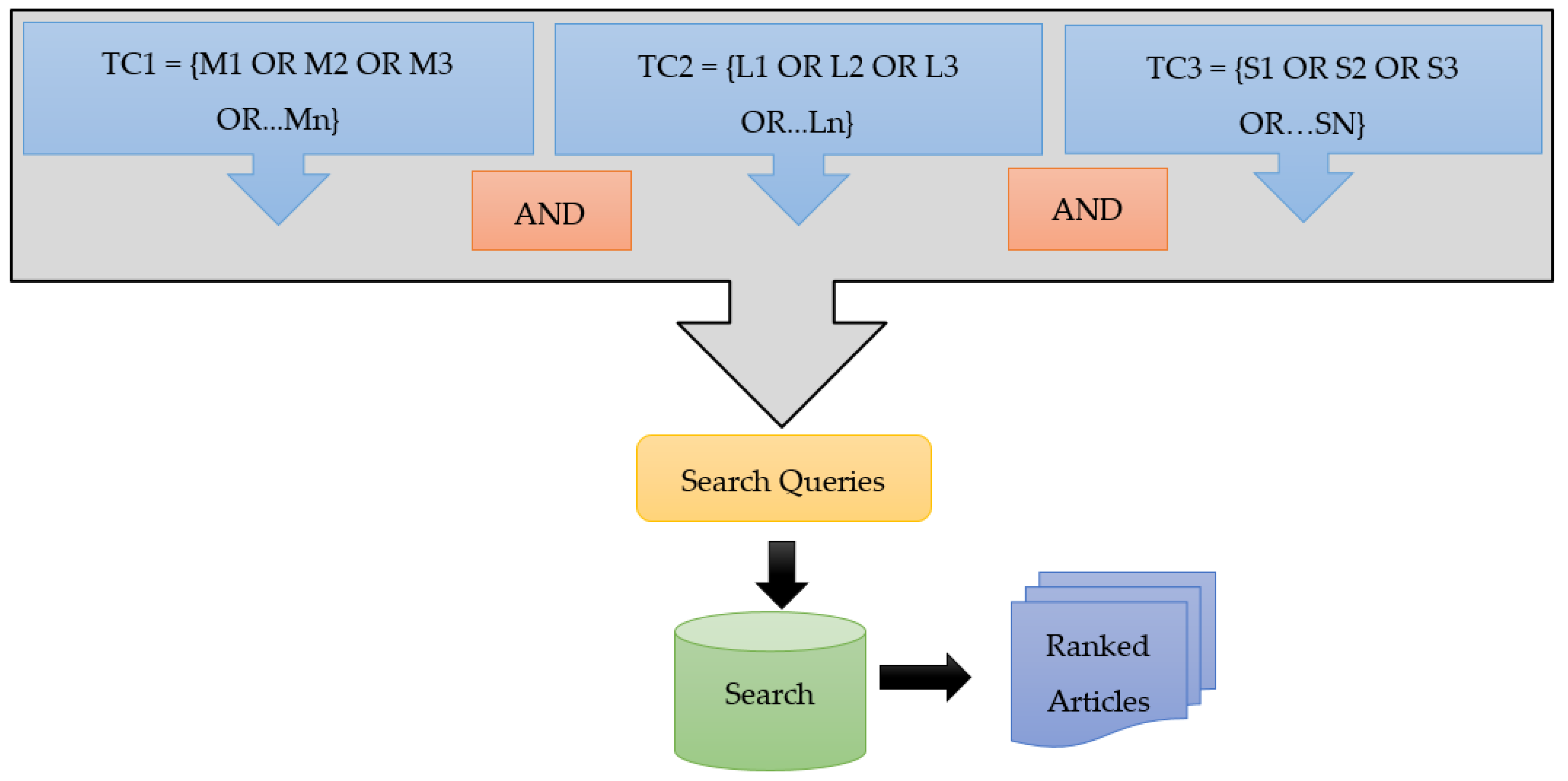
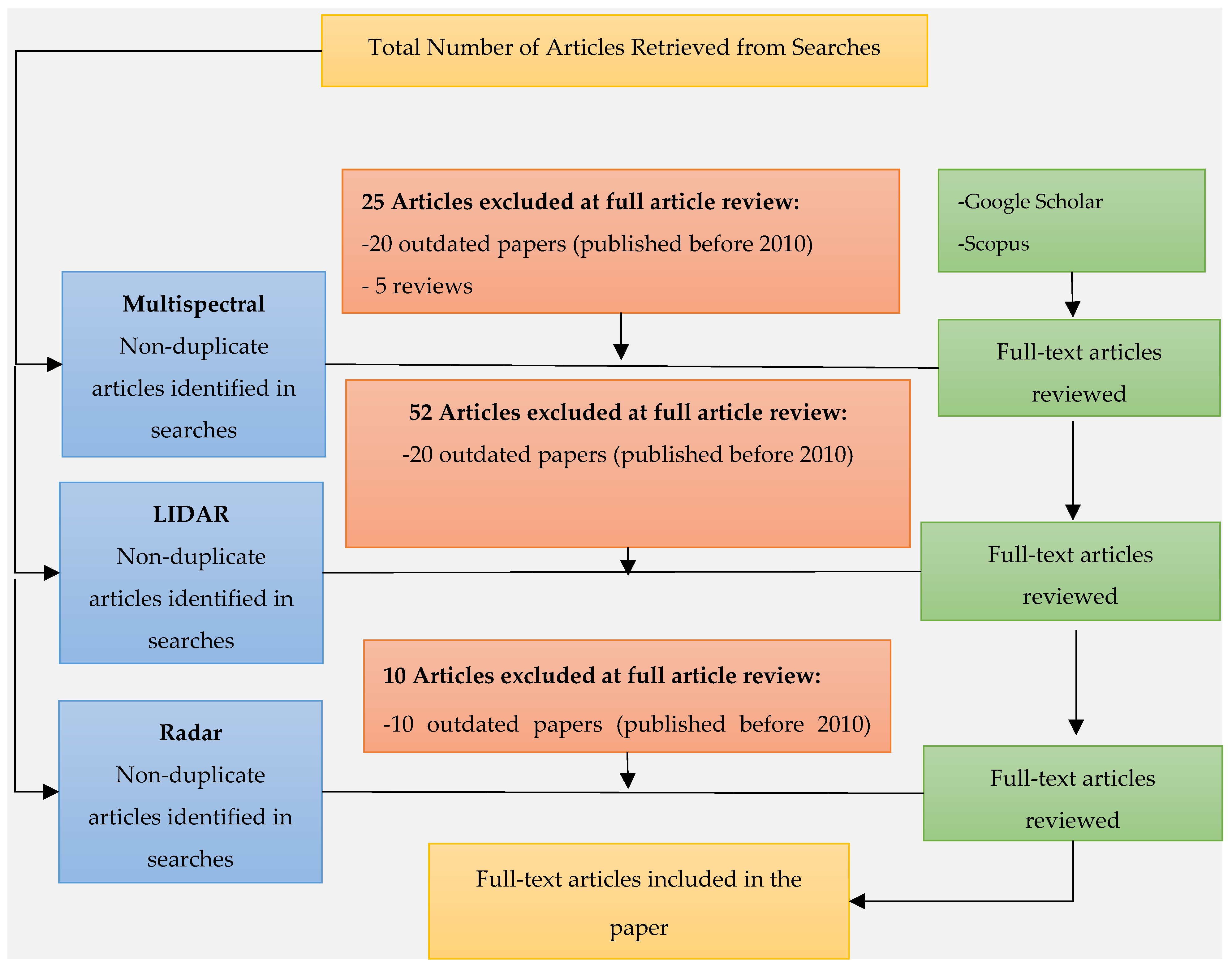

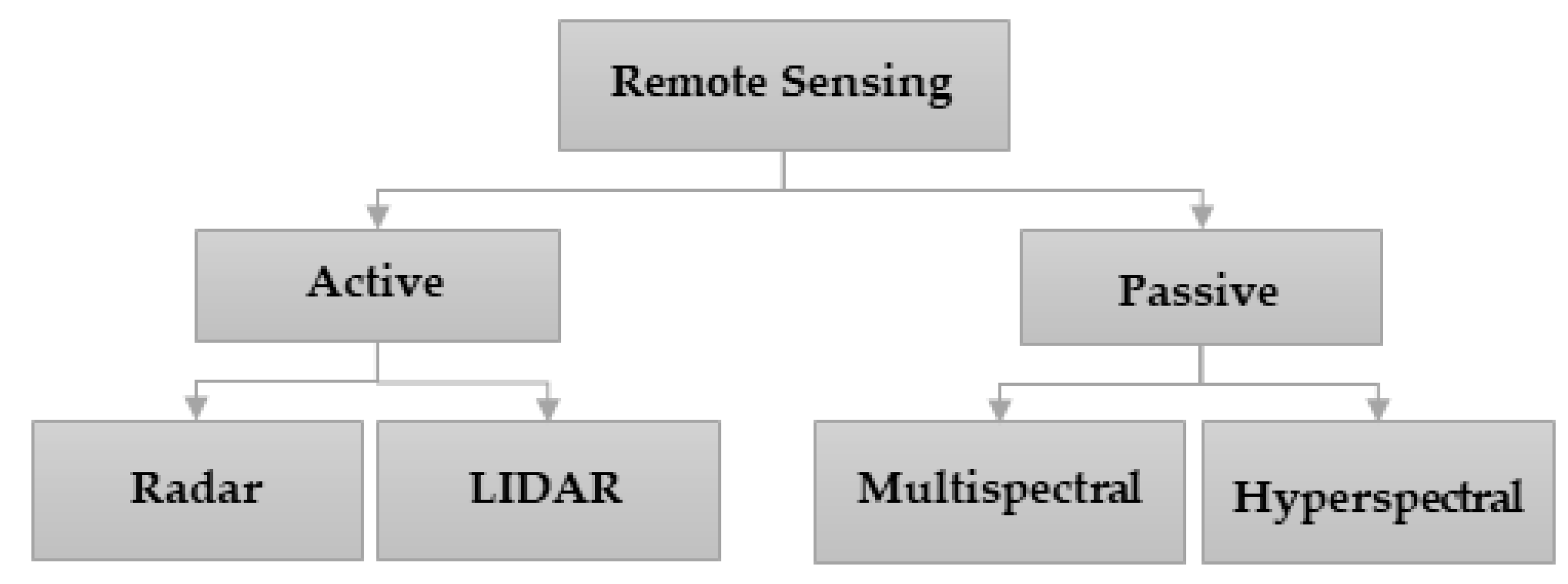
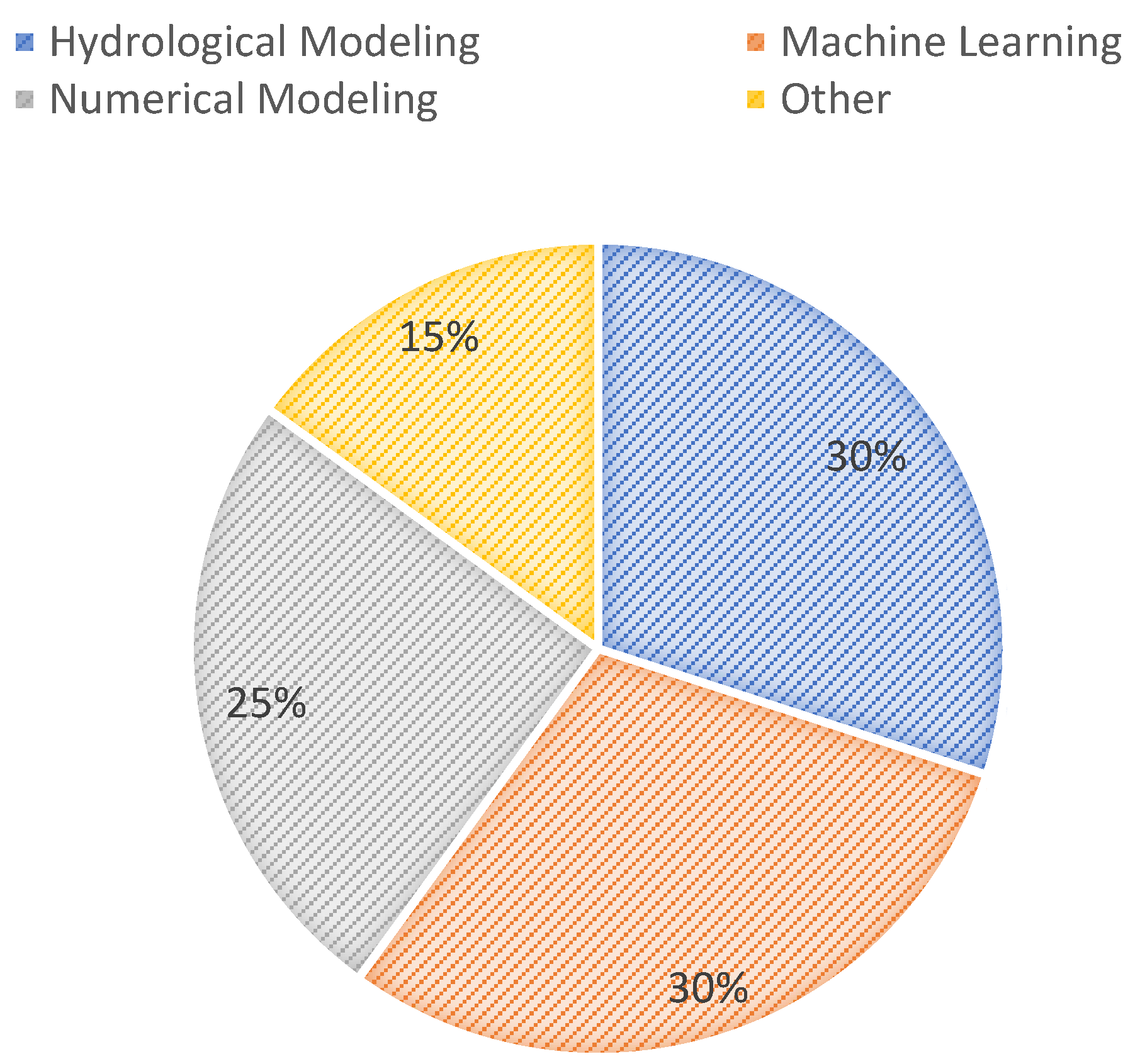
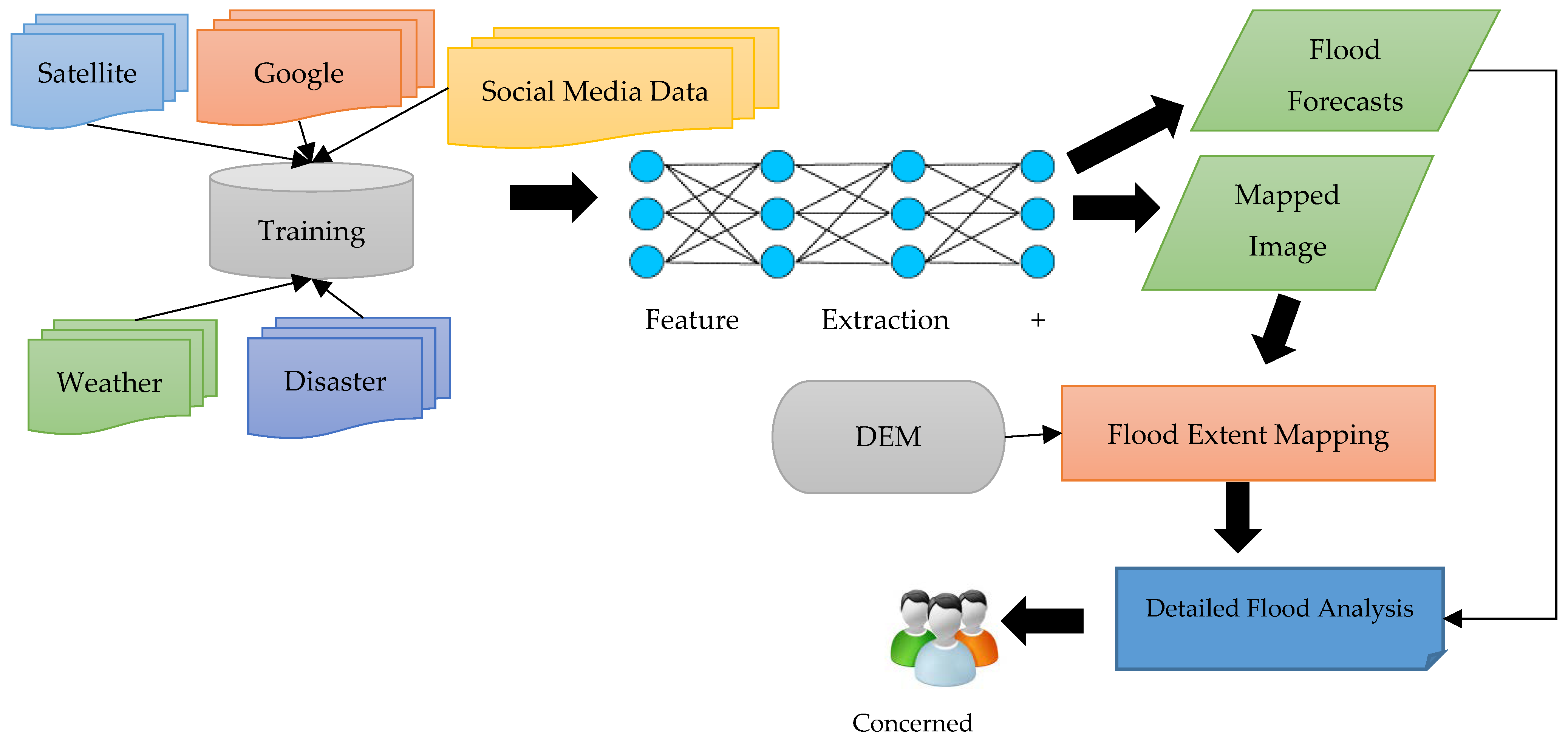
| Abbreviation | Full-Form |
|---|---|
| AI | Artificial Intelligence |
| ASCAT | Advanced Scatterometer |
| AWEI | Automated Water Extraction Index |
| CNN | Convolutional Neural Network |
| DEM | Digital Elevation Model |
| DSM | Digital Surface Model |
| ECV | Essential Climate Variables |
| ETKF | Ensemble Transform Kalman Filter |
| EO | Earth Observations |
| GIS | Geographic Information System |
| KNN | K-Nearest Neighbour |
| LIDAR | Light Detection and Ranging |
| LSTM | Long Short-Term Memory |
| MNDWI | Modified Normalized Difference Water Index |
| MISDc | Modello Idrologico Semi-Distribution in continuo |
| MODIS | Moderate Resolution Imaging Spectroradiometer |
| ML | Machine Learning |
| NDWI | Normalized Difference Water Index |
| RGA | Region Growing Algorithm |
| RNDWI | Revised Normalized Difference Water Index |
| RNN | Recurrent Neural Networks |
| SAR | Synthetic Aperture Radar |
| SVM | Support Vector Machine |
| TSRM | Tianshan Snowmelt Runoff Model |
| UK | United Kingdom |
| UAV | Unmanned Aerial Vehicle |
| WRF | Weather Research and Forecasting |
| Method | Domain | Features | Imaging Technology | Study Area | Results (% Accuracy) | Limitation | Ref |
|---|---|---|---|---|---|---|---|
| Convolutional Neural Network | Machine Learning | Water level Monitoring | Landsat TM, Sentinel-2 | Bihar, India | Overall accuracy (OA) = 0.93 kappa (K) = 0.87 | Need enhanced segmentation to support higher resolution imagery | [40] |
| Modello Idrologico Semi-Distribuito in continuo (MISDc) Model | Hydrological Modelling | Flood Forecasting | Metop A and B | Mediterranean Sea | Satellite-based data show improved results than ground-based data, with 100% efficiency | Results may be case specific | [41] |
| Bagging-Cubic-KNN | Machine Learning | Flood Susceptibility Mapping and detection | Sentinel-1 | Haraz, Iran | The area under the ROC curve (AUC) = 0.80 | - | [42] |
| Bayesian Linear | Machine Learning | Urban Pluvial Flood Forecasting | Sentinel-1 | Pattani, Thailand | Improved results over a neural network and decision tree | Rainfall intensity found to be a weak predictor of floods | [43] |
| Support Vector Machines | Machine Learning | Urban Flood Mapping | MODIS & Landsat | New Orleans | Blending multisource images produce better results | Over or underestimation of flooded regions for urban areas | [44] |
| Continuum | Hydrological Modelling | Flash Flood Forecasting | Sentinel-1 | Mediterranean catchment | Discharge Prediction results improved using Sentinel-1 data | Data recorded for a short period | [45] |
| Geodetically level gauge stations in water bodies | Hydrological Modelling | Modelling floodplain flow, processes, and fluxes in rivers | ICESat spaceborne Earth-orbiting laser altimeter | 400km Amazon River | Accuracies of 10 ± 27 cm | Some uncertainties in results due to tidal influences | [46] |
| Generation of essential climate variables (ECV) for lakes | Numerical Modelling | Water surface-level variation calculation | Public web databases providing imagery of satellites instruments | - | Accuracy up to a decimeter level | - | [47] |
| WRF Model | Numerical Modelling | Flood Prediction | DEM, MODIS | Juntanghu Watershed, China | Determination Coefficients = 0.85, 0.82 for 2 years respectively | WRF Model | [48] |
| Classification, RGA, Thresholding | Image Processing | Mapping Flood Prone Areas | Sentinel-1, SAR, DEM | Po River, Italy | User Accuracy = 60–80% | - | [49] |
| MNDWI RNDWI AWEI Otsu Threshold Google Earth Engine | Hydrological Modelling | Open Surface River Extraction | Sentinel-2, DEM | Upper Yellow River, Tibetan Plateau | Root mean square error (RMSE) = 16.148 m | - | [50] |
| Method | Domain | Features | Imaging Technology | Study Area | Results (% Accuracy) | Limitation | Ref |
|---|---|---|---|---|---|---|---|
| DEM | 3D Modelling | Flood risk mapping | LIDAR, GPS | Annapolis Royal, Nova Scotia, Canada | Accuracy > 30 cm | - | [23] |
| DEM, HEC-GeoRAS | 3D Modelling, Hydraulic Modelling | Flood Warning System | LIDAR | Grand River near the City of Painesville, Ohio | RMSE = 0.37–0.98 | Need accurate river streamflow data | [41] |
| HEC-RAS | Hydraulic Modelling | Flood return period prediction | LIDAR, Survey data | River Reach, Piedmont area of North Carolina. | LIDAR data predictions are 7% more accurate than survey data predictions | The method needs to be tested under varying climates | [51] |
| HEC-RAS | Hydraulic Modelling | Flood Forecasting & Early Warning | LIDAR | Philippines | Provide flood forecasts for the next 6–12 h | Method not backed by experiments and validation results | [52] |
| HEC-RAS, DEM | Hydraulic Modelling, 3D Modelling | Flood risk mapping | LIDAR | North-Eastern Romania | Accuracy = 0.5 m | Need high-resolution DEMs for accurate results | [53] |
| Method | Domain | Features | Imaging Technology | Study Area | Results | Limitation | Ref |
|---|---|---|---|---|---|---|---|
| Interferometric coherence for floodwater detection | Electromagnetic Modelling | Real-time assessment of flooded regions | SAR | Urban Areas | Demonstrate successful flood mapping in the presence of wind | Concerns about the reliability of wind speed data | [70] |
| Classification of global auxiliary data using fuzzy logic | Machine Learning | Online Flood mapping | TerraSAR-X SAR, 175 images | Thailand and Germany | Thailand: 87.5%, Germany: 91.6% | Increased missed alarm rates due to noise | [49] |
| Flash flood simulation using numerical methods | Numerical Modelling | Flood Warning System | SAR | Dubuque, Iowa | Rainfall totals estimated comparable to the observed event | Need to develop a more generalized picture of the dynamics | [40] |
| ETKF, Filter Localization | Numerical Modelling | Flood Forecasting | SAR | Severn & Avon rivers, UK | Feasible to work as a standalone model | - | [57] |
| PBD | Hydrological Modelling | Flash Flood Forecasting | S-band NEXRAD (WSR-88D) | Austin City | RMSE = 0.89 m | [66] |
Publisher’s Note: MDPI stays neutral with regard to jurisdictional claims in published maps and institutional affiliations. |
© 2022 by the authors. Licensee MDPI, Basel, Switzerland. This article is an open access article distributed under the terms and conditions of the Creative Commons Attribution (CC BY) license (https://creativecommons.org/licenses/by/4.0/).
Share and Cite
Munawar, H.S.; Hammad, A.W.A.; Waller, S.T. Remote Sensing Methods for Flood Prediction: A Review. Sensors 2022, 22, 960. https://doi.org/10.3390/s22030960
Munawar HS, Hammad AWA, Waller ST. Remote Sensing Methods for Flood Prediction: A Review. Sensors. 2022; 22(3):960. https://doi.org/10.3390/s22030960
Chicago/Turabian StyleMunawar, Hafiz Suliman, Ahmed W. A. Hammad, and S. Travis Waller. 2022. "Remote Sensing Methods for Flood Prediction: A Review" Sensors 22, no. 3: 960. https://doi.org/10.3390/s22030960
APA StyleMunawar, H. S., Hammad, A. W. A., & Waller, S. T. (2022). Remote Sensing Methods for Flood Prediction: A Review. Sensors, 22(3), 960. https://doi.org/10.3390/s22030960






